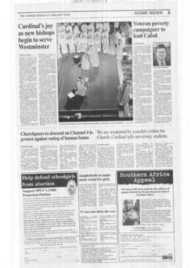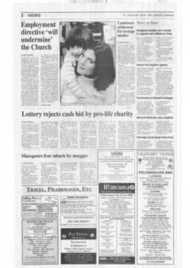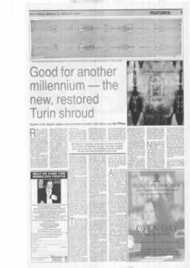Page 10, 31st January 2003
Page 10

Report an error
Noticed an error on this page?If you've noticed an error in this article please click here to report it.
Tags
Share
Related articles
The Complete Mastery Of Light
Classic Artwork Bought For A Song Thumbs Up
Hockney Delivers A Kick In The Face
Back To The Future
The Music Of The Line
Loving what you don't believe in
Fine Arts Patrick Reyntiens
There is a wonderful exhibition at the Dulwich Picture Gallery until March 3, of the drawings, paintings and illustrations of Arthur Rackham. Many who were burn this side of 1960 may never have even heard of him, yet he remains one of the greatest and most skilful draughtsmen born in the last 150 years. His style was formed between 1895 and 1911 and this mastery coincided with the new form of art and architecture, the Art Nouveau, where all the freedom and invention in English illustration, which had been neglected since Hogarth, Gillray and Cruikshank, was re-invented in the new most exciting style of Brussels and Paris. This urge for drawing coincided at the same time with the invention of new colour processes which, for the first time, made the colour illustration of books so perfect and sensitive that the most delicate washes of watercolour could be reproduced accurately. The temptation was too good to resist for Arthur Rackham, and his life work was defined in the repeated production of beautiful illustrated books. The urge to read fully illustrated books certainly persisted until the late 1920s. but then the experience of individual reading was surrendered to the communal experience of going to the cinema once or twice a week. The great illustrated book had had its day.
Nevertheless, Arthur Rackham persisted in his Art Nouveau style until his death in 1939, just as war was breaking out, curious that this 1890s style persisted throughout the period of change and innovation. non-figuration and cubism, Art Deco and Modernism. None of these stylistic invention of the Twenties and Thirties touched Arthur Rackham in the slightest. His exquisite art of pen and pencil and watercolour wash was unchanged.
It was a two-edged weapon, the illustrated book. It afforded a very stable living. The spate of specially printed books — in fine or limited editions — that resulted from the invented processes, was a completely new phenomenon But it was wildly popular; so much so that every family of any standing in England and Scotland held copies of Rack ham's illustrated books and treasured them. He illustrated JM Barrie, fairy tale books galore and special editions of Richard Wagner's operas. But the price for such popularity and fame was the virtual imprisonment of the illustrator within the metier of his illustrations, The illustrator could not assume any other identity but that of his choosing, an illustrator. No matter whether he was a potentially good painter, of landscapes or of the human face and figure , he could not escape. Typecast from the beginning, Arthur Rackham's paintings and landscape drawings and figurative easel pictures, good and potentially excellent though they were — as we can appreciate from those on show at this exhibition — were of no avail in allowing him to be appreciated in other, perhaps more, prestigious, ways. A genius though he was, an illustrator he was typecast by society and that he remained; there was no escape.
Why was Rackham so phenomenally successful? Not only because of his style, superb though it was, but because of his subject matter. Which was fairies, for the most part. Why fairies? Everybody was crazy about fairies in the latter part of the nineteenth century. Andrew Lang, the prodigious Scottish author, writing book after book of Scottish history, was the author of no less than four books of fairy stories. The Blue Book, the Red Book, the Green Book and the Yellow Book all concerned with fairies, sold untold thousands of copies. People doted on fairies. They managed to love them and not to believe in them at one and the same time. How modem
can you get? Fairies were only dethroned by the ghastly reality of the 1914-18 war with its millions of casualties.
Arthur Rackham's depiction of fairies defined our imaginations of them for the rest of time. If you do not believe me just look at the influence he has had posthumously on the designs of The Lord of the Rings, from the Tolkein books. The general feeling is exactly similar to Rackham's multitude of designs for his edition of Wagner.
Why were fairies so important if no one believed in them? The answer lies in history. The English and Scots were deprived totally and for good, at the time of the Reformation, of the cult of the saints, either local ones or those famous throughout Christendom. For a thousand years people were used to invoking the saint for encouragement and inspiration. Now nothing. Such an enormous gap in the general consciousness, produced in so short a time, was bound to have a serious consequence. We all know that "Good Queen Bess", the Virgin Queen, took the place of the Virgin Mary in people's manipulated minds — but she didn't last that long, in spite of the hagiography of Edmund Spencer. The passing of the seventeenth century and the 'Enlightened' eighteenth left nothing to look up to save Nelson and Wellington. Except in Germany and Denmark, perhaps, folk tales had dried up. So, forget the veneration of the saints and back come the fairies. And fairies were followed hotly by teddy bears. You can go to groups in certain churches now of "Prayers and Bears", but it is only for the under-10s. For those above the "age of belief", there are CD-Rams of extraterrestrial activities and Star Wars and Harry Potter.
Heigh-ho, nothing new under the sun. If the cult of the saints evaporated into the realms of fairy-land, the latest fad of anti-hamburger living, the "detoxification" regime that all are encouraged to go in for after Christmas excess, surely has its origin in Lent. Six weeks of no milk, no meat, no butter or cream, no alcohol, no tea or coffee — just fish, and vegetables and porridge and only water to drink — will do miracles for your figure and make you feel far better physically as Holy Week comes nearer. The feeling of physical rebirth will parallel the renewal of the spirit in the glory of Eastertide. Just don't rely on fairies.
blog comments powered by Disqus















